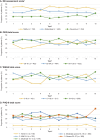Impact of Emotional Blunting on Patient Social Function and Depressive Symptoms: A Post Hoc Analysis of a Web-Based Survey in Japanese Patients with Major Depressive Disorder
- PMID: 40313313
- PMCID: PMC12045556
- DOI: 10.2147/NDT.S485109
Impact of Emotional Blunting on Patient Social Function and Depressive Symptoms: A Post Hoc Analysis of a Web-Based Survey in Japanese Patients with Major Depressive Disorder
Abstract
Background: Emotional blunting (EB), defined as a flattening of emotions and emotional indifference, is reported by many patients with major depressive disorder (MDD) taking antidepressants. Severity of EB correlates with depressive symptoms, as well as deficits in social function, anxiety and health-related quality of life. However, awareness and understanding of EB and its impact on treatment of MDD remain poorly understood.
Methods: This was a post hoc analysis of data from a web-based survey of 3376 adults with MDD in Japan. The primary endpoint was the correlation between total and subdomain scores of the Oxford Depression Questionnaire (ODQ; a validated instrument to assess EB) and total and individual domain/item scores of the Work and Social Adjustment Scale (WSAS) and Patient Health Questionnaire 9-item (PHQ-9). The secondary endpoint explored which patients had a discrepancy between EB symptoms (assessed by the ODQ) and their own evaluation of EB (using a validated screening question).
Results: There was a moderate correlation between the ODQ total score and the WSAS total score (Spearman's rank correlation coefficient [rs ] = 0.578) and a strong correlation between the ODQ total score and PHQ-9 total score (rs = 0.670). Multiple regression analyses showed that the ODQ subdomains "not caring" (NC) and "reduction in positive emotions" (PR) had the greatest impact on both the WSAS total score (partial regression coefficients = 1.034 and 0.501, respectively) and PHQ-9 total score (partial regression coefficients = 0.548 and 0.592, respectively). A higher proportion of men (versus women) and unemployed individuals (versus employed individuals) underestimated their EB severity compared with their ODQ score.
Conclusion: The ODQ subdomains of NC and PR are important factors when evaluating the impact of EB on social function and severity of depressive symptoms in patients with MDD. Physicians should assess EB symptoms for each patient, considering the patient's background.
Keywords: Oxford Depression Questionnaire; health-related quality of life; natural language analysis; online survey; patient health questionnaire 9-item; work and social adjustment scale.
© 2025 The Takeda Pharmaceutical Company Limited.
Conflict of interest statement
TK has received consultant fees and speaker’s honoraria from Lundbeck Japan K.K and Takeda Pharmaceutical Co., Ltd., and speaker’s honoraria from Mochida Pharmaceutical Co., Ltd., MSD K.K., Otsuka Pharmaceutical Co., Ltd., Sumitomo Pharma, and Viatris Inc. JI has received grant funding from the Japan Society for the Promotion of Science and speaker’s honoraria from Daiichi Sankyo, Eisai, Eli Lilly, Janssen Pharmaceuticals, Kowa Company, Kyowa Pharmaceutical Industry, Lundbeck Japan, Meiji Seika Pharma, Mochida Pharmaceutical, Mylan, MSD K.K., Nobelpharma, Novartis Pharma K.K., Nippon Boehringer Ingelheim, Ono Pharmaceutical, Otsuka, Sanofi K.K., Sawai Pharmaceutical, Shionogi, Sumitomo Dainippon Pharma, Takeda Pharmaceutical, Viatris, Yonyaku, and Yoshitomi Yakuhin. AH, FT, and TH are employees of Takeda Pharmaceutical Company Limited. YM is an employee of Lundbeck Japan K.K. The authors report no other conflicts of interest in this work.
Figures


References
-
- World Health Organization. Depressive disorder (depression). Available from: https://www.who.int/news-room/fact-sheets/detail/depression. Accessed April 22, 2024.
LinkOut - more resources
Full Text Sources
Research Materials

